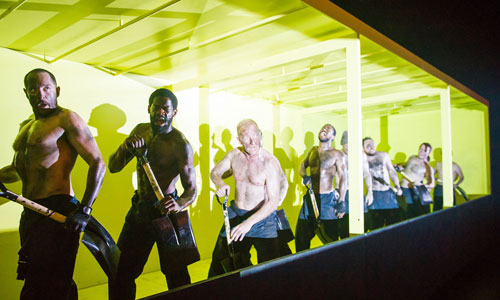|
The
Guardian, October 29, 2015
The Hairy Ape
review – an expressionist spectacle of caged
humanity
By Michael Billington
 |
An indelible
impression … Bertie Carvel (Yank) and fellow
cast members in The Hairy Ape.
Photograph: Tristram Kenton for the Guardian |
Eugene O’Neill’s 1922
play is a devil to stage. But Richard Jones’s
production, running 90 minutes as opposed to the
four hours of the Peter Stein version seen at the
National in 1987, succeeds by treating the play for
what it is: a stunning expressionist spectacle in
which images count as much as words.
O’Neill’s protagonist Yank – played with an
adenoidal Brandoesque drawl by Bertie Carvel – is a
truculent stoker on a transatlantic liner who
deludes himself that he belongs in the new
machine-made world: “I’m de muscles in steel,” he
proudly boasts, “de punch behind it.” In eight short
scenes, O’Neill shows Yank to be kidding himself.
Dismissed as “a filthy beast” by an industrial
tycoon’s daughter, Yank displays a rampaging
violence that disturbs even his own shipmates.
Vowing class revenge, Yank finds himself rejected
wherever he turns: by the Fifth Avenue socialites he
insults and by the unionised Industrial Workers of
the World for whom he proves too explosive. Only in
the Zoo, where he confronts a caged gorilla, does
Yank meet a kindred spirit, but that too proves an
illusion.
 |
Superb visuals
… Stewart Laing’s design and Mimi Jordan
Sherin’s set.
Photograph: Tristram Kenton for the Guardian |
The power of Jones’s
production lies in reminding us of how much 1920s
American drama owed to German expressionism. Stewart
Laing’s design and Mimi Jordan Sherin’s lighting
create a series of unforgettable images, including
the sulphurous hell of the ship’s stokehole, the
ghoulish parade of the masked New York bourgeoisie
and the antiseptic orderliness of the union
headquarters, with its uniform volumes stacked on
underpopulated shelves.
Superb as the visuals
are, I wish that Jones’s production paid more
attention to O’Neill’s language. Edmund Wilson once
shrewdly observed that, whereas O’Neill’s
middle-class characters are prosily repetitive, a
working-class figure like Yank has “a mouth-filling
rhythmical eloquence.” Yank, after all, revealingly
says: “I ain’t got no past to tink in, nor nothin’
dat’s comin’, on’y what’s now.” To be fair, that
line sings out in Bertie Carvel’s fine performance,
which exactly catches Yank’s social alienation and
internal struggle.
Carvel, as we know from his Miss Trunchbull in
Matilda, has an extraordinary physicality that,
whether shovelling coal into a ship’s furnace or
swinging from a steel girder on Fifth Avenue, he
leaves behind an indelible impression. It’s a
courageously inventive performance that few of his
contemporaries could match, but even Carvel could do
more to relish the language. But that is my only
cavil about a rare and exhilarating revival of a
play that shows the ability of expressionism to pin
down the encaged isolation of the eternally
oppressed.
|